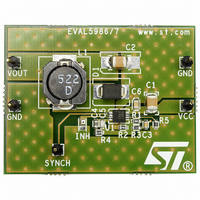EVAL5987 STMicroelectronics, EVAL5987 Datasheet - Page 30

EVAL5987
Manufacturer Part Number
EVAL5987
Description
BOARD EVALUATION FOR L5987
Manufacturer
STMicroelectronics
Type
DC/DC Switching Converters, Regulators & Controllersr
Specifications of EVAL5987
Main Purpose
DC/DC, Step Down
Outputs And Type
1, Non-Isolated
Voltage - Output
1.8V
Current - Output
3A
Voltage - Input
2.9 ~ 18V
Regulator Topology
Buck
Board Type
Fully Populated
Utilized Ic / Part
L5987
Input Voltage
2.9 to 18 V
Output Voltage
1.8 V
Operating Supply Voltage
2.9 to 18 V
Product
Power Management Modules
Lead Free Status / RoHS Status
Lead free / RoHS Compliant
Power - Output
-
Frequency - Switching
-
Lead Free Status / Rohs Status
Lead free / RoHS Compliant
For Use With/related Products
L5987
Other names
497-8369
Available stocks
Company
Part Number
Manufacturer
Quantity
Price
Application information
6.6
30/41
of heat. The Rth
paragraph is about 60 °C/W for the VFQFPN package and about 40 °C/W for the HSOP
package.
Figure 17. Switching losses
Layout considerations
The PC board layout of switching DC/DC regulator is very important to minimize the noise
injected in high impedance nodes and interferences generated by the high switching current
loops.
In a step-down converter the input loop (including the input capacitor, the power MOSFET
and the free wheeling diode) is the most critical one. This is due to the fact that the high
value pulsed current are flowing through it. In order to minimize the EMI, this loop has to be
as short as possible.
The feedback pin (FB) connection to external resistor divider is a high impedance node, so
the interferences can be minimized placing the routing of feedback node as far as possible
from the high current paths. To reduce the pick up noise the resistor divider has to be placed
very close to the device.
To filter the high frequency noise, a small capacitor (220 nF) can be added as close as
possible to the input voltage pin of the device.
Thanks to the exposed pad of the device, the ground plane helps to reduce the thermal
resistance junction to ambient; so a large ground plane enhances the thermal performance
of the converter allowing high power conversion.
In
Figure 18
a layout example is shown.
JA
measured on the demonstration board described in the following
Doc ID 14972 Rev 3
L5987













